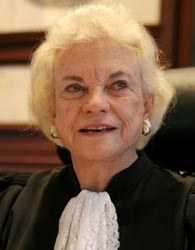Sandra Day O’Connor endured a great deal of gender-based prejudice before she became the first woman to serve as a Supreme Court justice. During her years on America’s highest court, she cast the swing vote in several key cases.
Sandra Day O’Connor’s Early Days
Sandra Day O’Connor was born on March 26, 1930, in El Paso, Texas, to Harry and Ida Mae Day. Her earliest days were spent on the Lazy B, her family’s rustic southeastern Arizona cattle ranch, where she learned to ride horses, drive a truck and fire a rifle by the time she was eight.
Living on the remote ranch offered few opportunities for formal education, so O’Connor went to live with her maternal grandmother in El Paso, Texas, where she attended the Radford School. She graduated from high school at age 16, and then went on to Stanford University. She majored in economics, hoping this discipline would one day help her operate the ranch. However, a legal dispute involving the Lazy B got her interested in law. After receiving her undergraduate degree in 1950, O’Connor enrolled in law school at Stanford, where she met her future husband, Stanford law school student John Jay O’Connor.
Sources in this Story
- Oyez: Sandra Day O’Connor
- Slate: A new look at Sandra Day O’Connor
- Washington Post: Supreme Court Justice O’Connor Resigns
- ASU Sandra Day O’Connor College of Law: History of the College
- findingDulcinea: Students Know “American Idol” Better Than America, Says Sandra Day O’Connor
- iCivics.org
- The New York Times Magazine: Questions for Sandra Day O’Connor
O’Connor’s Notable Accomplishments
No California law firm wanted to hire a female attorney, so O’Connor pursued public service, becoming the deputy county attorney for San Mateo, California. A year later, her husband graduated from Stanford and the U.S. Army drafted him into the Judge Advocate General Corps. O’Connor accompanied him to Frankfurt, Germany, where she worked as a civilian lawyer in the Quartermaster’s Corps.
The couple returned to the United States in 1957 and settled in Phoenix, Arizona; again, O’Connor could not find a law firm willing to hire a female attorney. She started her own firm, and became increasingly involved with volunteer activities and raising her children.
She returned to public service as an assistant state attorney general and shortly thereafter, was appointed as an Arizona state senator. She was re-elected twice and became the first woman in the country to serve as a state senate majority leader. She was then appointed as a judge on Arizona Court of Appeals. Less than two years later, President Reagan nominated O’Connor to the Supreme Court; she was unanimously confirmed by the Senate.
Brought on to be a conservative voice, O’Connor established a more moderate position. According to a Slate article, “the most striking aspect of O’Connor’s record is her effort to steer between what she sees as the extremes of either side.” During her years in the Supreme Court, she developed a reputation for appreciating the fine nuances of the law, and for casting the deciding vote in key cases when the Court was split.
The Woman and Her Work
- “The Majesty of the Law: Reflections of a Supreme Court Justice” by Sandra Day O’Connor
- “Lazy B: Growing up on a Cattle Ranch in the American Southwest” by Sandra Day O’Connor and H. Alan Day
- “Sandra Day O’Connor: How the First Woman on the Supreme Court Became Its Most Influential Justice” by Joan Biskupic
- “The Nine: Inside the Secret World of the Supreme Court” by Jeffrey Toobin
The Rest of the Story
In 2005, Sandra Day O’Connor resigned from the Supreme Court to spend more time with her husband, who was in declining health and suffering from Alzheimer’s.
In recognition of her achievements, Arizona State University renamed their law school after O’Connor in 2006. Meanwhile, O’Connor has once again devoted herself to serving the community. She lectures at various institutions about law and education.
In March 2009, O’Connor told “Good Morning America” that more Americans can name a judge on “American Idol” than can name the three branches of government. Concerned that young people lack civic knowledge, she founded a web site, Our Courts: 21st Century Civics, directed at middle-school students, which in 2010 became iCivics.org.
That same month, she also spoke to The New York Times Magazine about the site and her career. While she has always “care[d] very much about women and their progress,” she doesn’t want to be labeled a feminist. Rather, she’d like to be known as “A fair judge and a hard worker.”
This article was originally written by Jen O’Neill; it was updated February 21, 2017.











